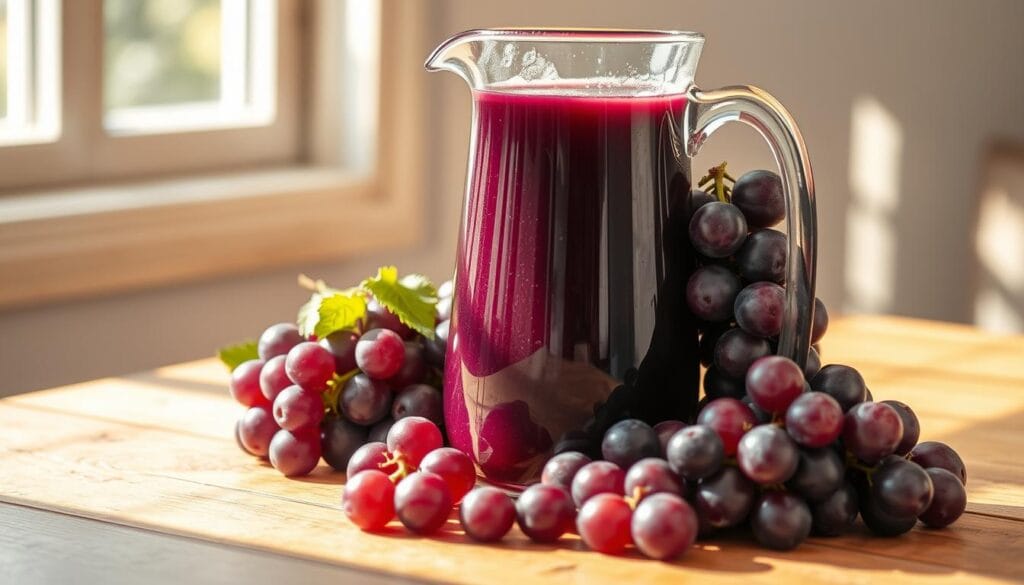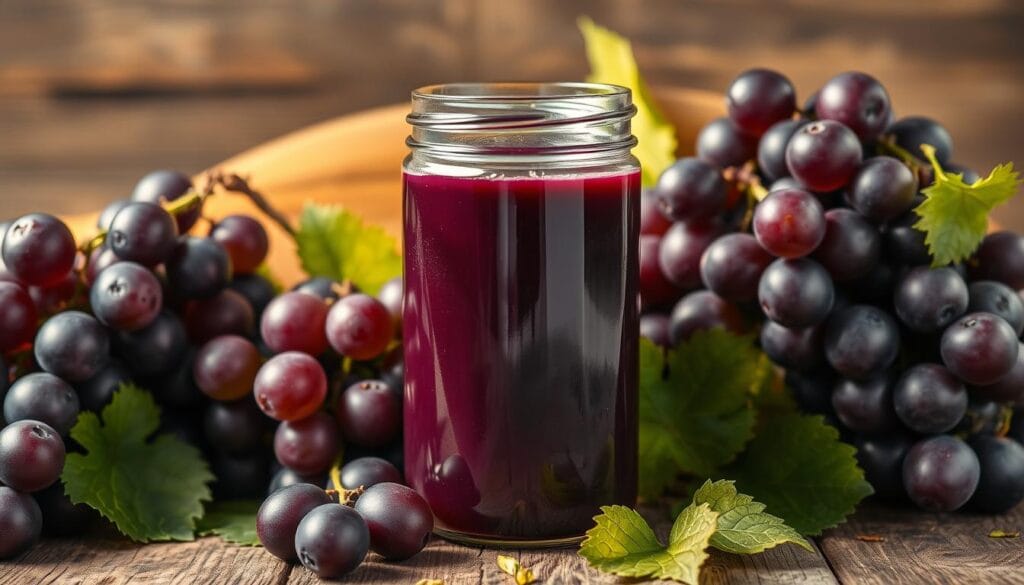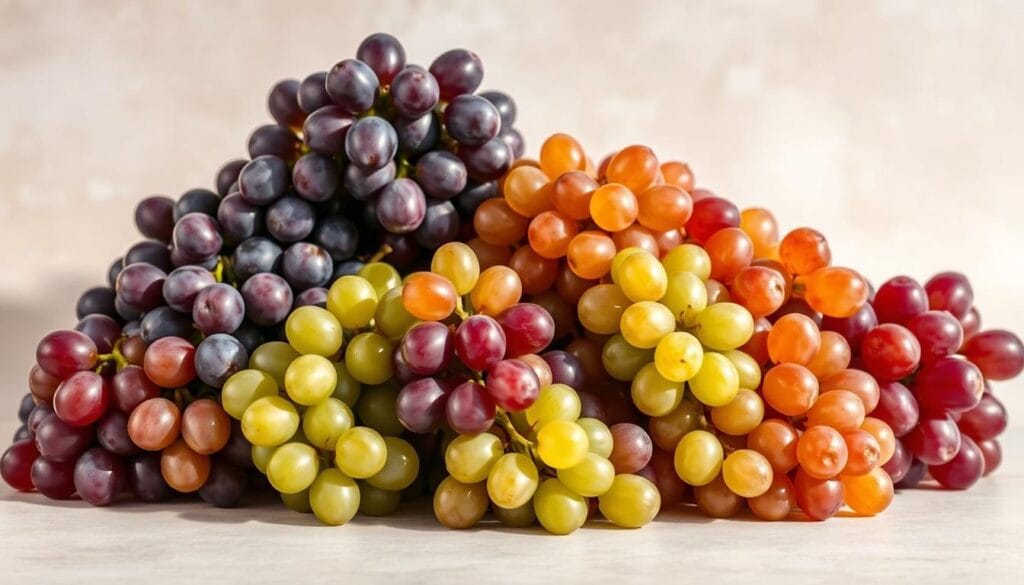“Learn how to make fresh grape juice at home with simple steps and natural ingredients. Discover the sweet, pure taste of homemade grape juice without additives or preservatives

Making your own grape juice at home turns a simple drink into a special treat. By choosing top-quality grapes, you get a drink full of natural taste and health benefits. This is something store-bought juice can’t offer.
Homemade grape juice lets you pick every ingredient, making sure it’s clean and free from additives. From picking the right grapes to making and storing the juice, it’s a fun journey. It connects you to the fresh, healthy stuff you’re using.
By making grape juice yourself, you can try out different grape types. You’ll learn which ones taste the best. Whether you like sweet Concord grapes or fancy Muscadine grapes, your juice will always be amazing.
Key Takeaways
- Homemade grape juice provides superior taste and nutrition
- Control ingredients and avoid artificial additives
- Explore diverse grape varieties for unique flavors
- Enjoy a fresh, pure beverage made with your own hands
- Create healthier alternatives to commercial grape juice
Benefits of Making Your Own Grape Juice at Home
Making grape juice at home is great for your health, wallet, and the planet. It lets you enjoy fresh, nutritious juice that store-bought options can’t match.

Homemade grape juice is full of health benefits. It’s packed with antioxidants and resveratrol, which boost your overall health.
Nutritional Powerhouse
Homemade grape juice is a nutritional powerhouse. It has natural compounds from fresh grapes that are good for you:
- Rich in resveratrol, which supports heart health
- High concentration of antioxidants that combat free radicals
- Natural source of essential vitamins and minerals
Economic Advantages
Making your own grape juice can save you money. Here’s how:
| Juice Type | Average Cost per Serving | Annual Savings |
|---|---|---|
| Store-Bought Juice | $2.50 | $0 |
| Homemade Juice | $0.75 | Up to $660 |
Environmental Sustainability
Homemade grape juice is better for the environment. It reduces packaging waste, supports local farmers, and cuts down on carbon emissions.
The fresh, vibrant flavor of homemade grape juice is a big plus. It’s good for your health, your wallet, and the planet.
Selecting the Perfect Grapes for Juicing
Choosing the right grapes is key to making tasty homemade juice. Your journey into viticulture starts with knowing which grapes are best for juicing. Not all grapes are equal in flavor and nutrition for juice.

Different grape varieties have unique traits for your homemade juice. Some grapes are better for juicing than others. This depends on their natural sugar levels and juice potential.
| Grape Variety | Juice Characteristics | Best Season |
|---|---|---|
| Concord | Rich, sweet, deep purple juice | Late Summer |
| Thompson Seedless | Light, refreshing, mild flavor | Mid-Summer |
| Red Globe | Intense, robust flavor | Early Fall |
Choose grapes that are plump, deeply colored, and without bruises or mold. Local farmers markets often have the freshest grapes for juicing. Knowing basic viticulture helps you pick the tastiest grapes for your juice.
Pro tip: The season affects grape quality. Summer and early fall have the best grapes for juicy, ripe juice.
Essential Equipment for Making Grape Juice
When making grape juice at home, picking the right tools is key. Whether you’re just starting or want to make more, knowing what you need can make a big difference.
Starting your grape juice journey means choosing the right tools. These tools help make sure your juice is top-notch, safe, and easy to make.
Basic Tools and Appliances
Here’s what you need to begin:
- Large stainless steel or glass crushing pot
- Sturdy food-grade pressing device
- Fine mesh strainer or cheesecloth
- Measuring cups and spoons
- Sharp grape harvesting shears
Optional Equipment for Large-Scale Production
If you want to make more juice like a winery, you might need:
- Electric fruit press
- Commercial-grade juicer
- Large fermentation containers
- Bottling system with multiple spouts
- Industrial-strength grape destemmer
Sterilization and Safety Equipment
Keeping things clean is very important. You’ll need:
- Sanitizing solution
- Sterilizing tablets
- Heat-resistant gloves
- Alcohol-based cleaning agents
- Disposable or washable food-grade gloves
Remember, clean equipment ensures safe and delicious grape juice every time!
Step-by-Step Guide to Making Fresh Grape Juice
Making grape juice at home is simple. Just a few steps can turn fresh grapes into a tasty drink. It’s healthier than what you buy in stores.
First, get all your needed tools:
- Fresh, ripe grapes
- Large mixing bowl
- Colander
- Blender or juicer
- Fine-mesh strainer
- Clean glass bottles for storage
Choose your grapes wisely. Ripe, sweet grapes make the best juice. Rinse them well to get rid of dirt and chemicals.
“The secret to great grape juice is using the freshest, highest-quality grapes you can find.” – Culinary Expert
There are two ways to get the juice:
- Blender Method: Blend grapes until smooth, then strain through a fine-mesh strainer
- Juicer Method: Pass grapes directly through a juicing machine
After getting the juice, you can add honey for sweetness or keep it plain. Store it in the fridge and drink it within 3-5 days for the best taste and health benefits.
Pro tip: For clearer juice, let it sit for an hour. Then, pour off the top layer, leaving the sediment behind.
Understanding Different Grape Varieties and Their Flavors
Choosing the right grapes for your homemade juice can change your drinking experience. Each grape variety has its own flavor that can make your juice special. Knowing these differences helps you make the perfect juice for your taste.
Picking the right grapes is key in making juice, just like in wine making. Each type adds its own sweetness and character to the juice.
Red Grape Varieties for Juicing
Red grapes give juices deep, rich flavors. They can make juices bold and complex. Here are some great choices:
- Cabernet Sauvignon: Bold and intense flavor
- Merlot: Smooth and slightly sweet profile
- Pinot Noir: Light and delicate taste
White Grape Varieties for Fresh Juice
White grapes make lighter, refreshing juices with subtle flavors:
- Chardonnay: Crisp and clean taste
- Riesling: Sweet and aromatic
- Sauvignon Blanc: Zesty and bright
Popular Juicing Grapes
Some grapes are favorites for their classic juice flavors:
| Grape Variety | Flavor Profile | Best Use |
|---|---|---|
| Concord | Sweet and intense | Traditional juice making |
| Thompson Seedless | Mild and sweet | Versatile juicing |
| Muscadine | Rich and robust | Southern-style juices |
When picking grapes for juicing, think about the flavor intensity, sugar content, and your taste. Trying different grapes can help you find your favorite juice mix.
Storage and Preservation Methods for Homemade Grape Juice
Keeping your homemade grape juice fresh is key. You need to stop fermentation and keep its taste fresh. The right way to store it can make it last longer and keep its nutrients.
Refrigeration is the top choice for keeping grape juice fresh. Store it in airtight containers for 3-5 days. Glass containers are best to keep the juice’s taste pure.
- Cool temperatures slow down natural fermentation processes
- Use clean, sterilized containers before storing
- Keep juice away from direct light and heat sources
Freezing is a great way to keep grape juice for longer. You can freeze it in:
- Plastic freezer containers
- Ice cube trays for easy portions
- Sealed freezer bags
Canning is another good way to preserve grape juice. It stops vinegar from forming by controlling fermentation. Sterilize jars well and use water bath canning for safety.
Pro tip: Label your stored grape juice with the date of preparation to track freshness.
Natural fermentation can turn grape juice into vinegar if not stopped. Keep it cool and away from air to avoid this. Good storage methods will help you enjoy your grape juice the most.
Common Mistakes to Avoid When Making Grape Juice
Making grape juice at home can be tricky. Many people face challenges that affect the taste and quality of their juice. Knowing these common mistakes can help you make perfect grape juice every time.
To make great grape juice, you need to pay close attention and prepare well. Raisins might seem easy to use, but they’re not the best choice for fresh juice. Let’s look at the main mistakes to avoid.
Processing Errors to Watch Out For
- Avoid over-extracting grape juice, which can create a bitter taste
- Remove grape stems and leaves completely before juicing
- Use only fully ripe grapes for the best flavor profile
- Clean your equipment thoroughly to prevent contamination
Storage Mishaps That Can Ruin Your Juice
- Never store juice at room temperature for extended periods
- Use clean, sterilized containers for preservation
- Refrigerate immediately after preparing
- Consume fresh juice within 3-5 days for optimal taste
Quality Control Tips
Choosing the right grapes is key for great juice. Raisins should not be used as a substitute for fresh grapes. Look for grapes that are:
- Uniform color
- No visible mold or bruising
- Firm texture
- Sweet, fresh aroma
Tip: Always taste a few grapes before juicing to ensure peak ripeness and flavor!
By avoiding these mistakes, you’ll make delicious, fresh grape juice. Focus on your process, and you’ll become a grape juice expert quickly.
Creative Ways to Use Your Homemade Grape Juice
Your freshly pressed grape juice is more than a tasty drink. It can lead to exciting culinary adventures. You can turn it into something new and different.
Here are some creative ways to use your homemade grape juice:
- Craft delightful grape juice smoothies with fresh fruits
- Create frozen grape juice popsicles for summer treats
- Use as a natural sweetener in baking recipes
- Develop unique cocktail and mocktail combinations
If you love wine, you can start making your own. Just ferment your grape juice to create small-batch wines. With the right care and techniques, you can make a homemade wine.
Vinegar fans can also use grape juice. It turns into a tangy, tasty vinegar through fermentation. This vinegar is great for cooking and dressing salads.
“Creativity in the kitchen begins with understanding your ingredients” – Culinary Wisdom
Your homemade grape juice is very versatile. It’s up to you to decide how to use it. Whether it’s in drinks, fermentation, or frozen treats, every glass is a chance to explore new flavors.
Health Benefits of Pure Grape Juice
Pure homemade grape juice is packed with health benefits that commercial brands can’t match. The antioxidants in fresh grape juice protect your body from damage. They support your overall health. Making juice from whole grapes means you get more nutrients without added chemicals.
Resveratrol, found in grape skins, is great for your heart. Homemade grape juice has more of this good stuff than store-bought. Drinking it regularly might lower inflammation, improve heart health, and even boost brain function.
Freshly pressed grape juice boosts your immune system and gives you important vitamins. Unlike sugary store-bought juices, your homemade version keeps the grape’s natural goodness. Its antioxidants help fix cells and support long-term health.
By making your own juice, you get the best nutrition. Each glass is a natural health boost, without preservatives or extra processing. Your effort to make pure grape juice means you enjoy a drink that’s good for you.
FAQ
How long can homemade grape juice be stored?
Homemade grape juice lasts 5-7 days in the fridge. You can freeze it for up to 3 months. This keeps its taste and nutrients.
What are the best grape varieties for making juice?
Concord grapes are top for juice, with a sweet flavor. Niagara, Muscadine, and seedless grapes also work well. Each adds a special taste to your juice.
Do I need special equipment to make grape juice at home?
You can juice grapes with a juicer or blender. You’ll need a strainer, cheesecloth, pot, and clean bottles for storage.
Are there health benefits to drinking homemade grape juice?
Yes! Homemade grape juice is full of antioxidants like resveratrol. It’s good for your heart and may reduce inflammation. Fresh juice is better than store-bought.
Can I make grape juice without adding sugar?
Yes, many grapes are sweet enough on their own. For a sweeter taste, add a bit of honey or agave. But it’s not needed for ripe grapes.
How do I prevent my grape juice from fermenting?
Keep your juice cold and sealed. Refrigerate it right away. You can also pasteurize it briefly. Drink it within 5-7 days to avoid fermentation.
What’s the difference between homemade and store-bought grape juice?
Homemade juice has no preservatives or added sugars. It tastes fresher and is more nutritious. You control the making process. Store-bought juice may have lost nutrients and extra ingredients.
Can I use frozen grapes to make juice?
Yes, frozen grapes are great for juice. They make juicing easier and can make the juice sweeter. Just thaw them a bit before juicing.

